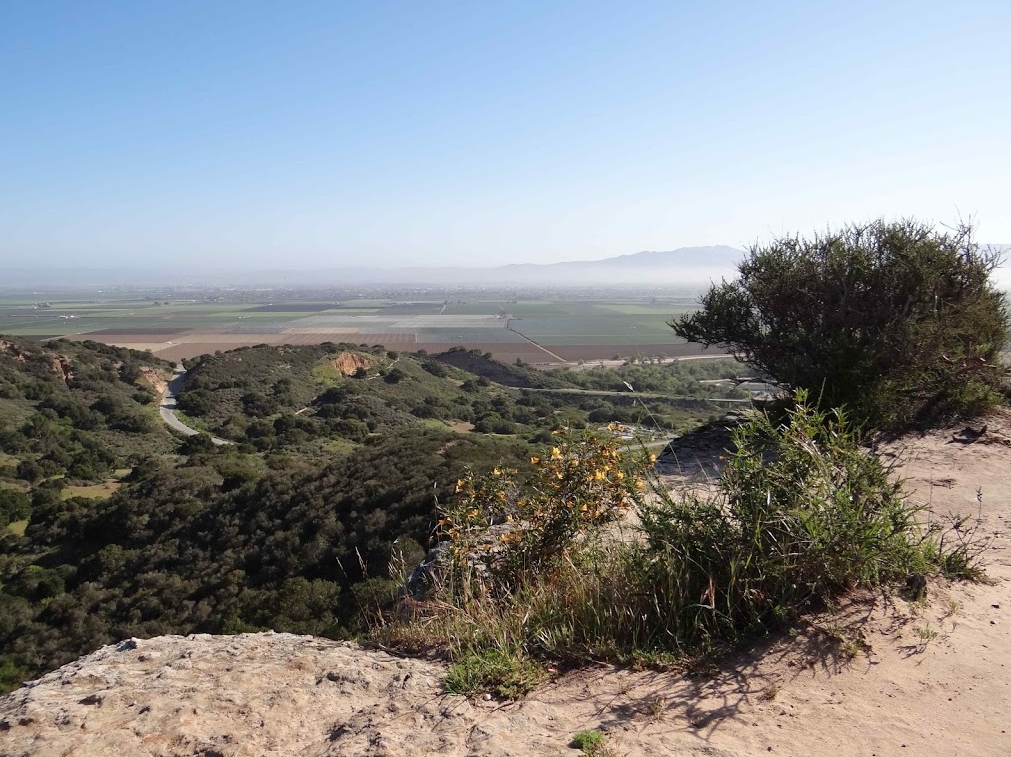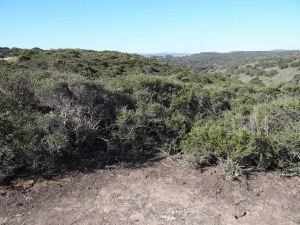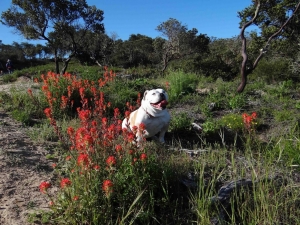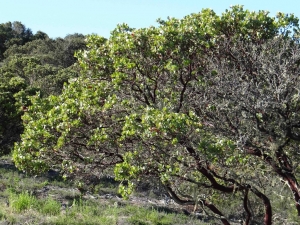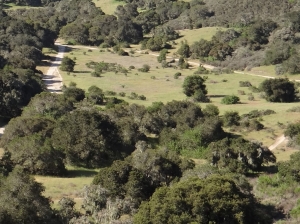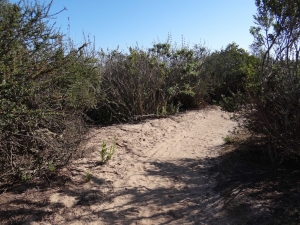Something good happened this week. With the stroke of a pen, President Obama, using the National Antiquities Act, turned the former Fort Ord, in Monterey, California, into a National Monument.
It may not mean a lot to folks who don’t live in the Monterey Bay Area, but it means a hell of a lot to Susan and I, because we pretty much spent our courtship there.
It was 1994, and the fort had just been closed as part of base realignment, and nobody really had a firm handle on the place for a while, and the public hadn’t really discovered it yet. It was a land of falling-down barbed wire fences, rusty signs warning of unexploded ordnance, derelict tanks and troop carriers left on the firing ranges for target practice getting gradually taken over by riotous vines and wildflowers as nature took possession again—and miles and miles of trails and closed roads through chaparral and oak woodlands. Hundreds of our happiest miles were spent in that place, training for marathons and wildlife watching at the same time.
We weren’t supposed to go on the firing ranges themselves, of course, but we couldn’t resist because they were such fabulous wildlife refuges. Military bases have been called the best-kept conservation secret in America. Usually when we say “wildlife refuge,” we mean somewhere human beings get to tromp around and look at wildlife, or even hook it or shoot it. Not so on those firing ranges. They truly did belong exclusively to the wildlife, and the only prints we saw were of animals. After a light rain the prints would be preserved in amazing detail, and we once stood on a sandy knoll and reconstructed almost completely a pretty dire struggle between a mountain lion and a deer. We couldn’t figure out who prevailed in the end, but we didn’t see a carcass around. On those runs we saw bobcats, foxes, coyotes and golden eagles, and on night runs we would see skunks, raccoons and great horned owls. We once chased a great horned owl fully two miles down a road one phone pole at a time, which kept us amused for a good twenty minutes (okay, for some runners it would have been more like fourteen, but a ten-minute mile isn’t bad when you’re wildlife watching). As we approached him each time we could almost hear him mutter something as he lumbered into the air again and flew ahead of us to the top of the next phone pole. He never figured out that all he needed to do was fly one phone pole back the other way. Owls, our favorite symbol of wisdom, are actually one of the stupider birds, it turns out, at least by the human yardstick that we always measure these things with. (Jays and crows are the smartest.)
Well, the firing range days finally came to an end and we began sticking to the legal roads and trails, because my brother Gary is a federal prosecutor up in San Jose, and trespassing on those firing ranges is a federal crime, and I found out that once a week he was driving down to Monterey to prosecute such things. So we cleaned up our act, rather than make Gary stand in front of a judge and say something like, “Your honor, I must recuse myself because the breathtakingly stupid defendant is my brother.”
When the fort first closed, there was no shortage of bad ideas about what to do with the place. Someone even suggested a huge amusement park (now there’s someone who should be sentenced to six months in Anaheim). It was largely our congressman, Sam Farr, who kept the worst from happening. The buildings on the developed part of the fort became California State University, Monterey Bay, and the city of Marina did get permission to build a thousand or so houses, but they only got as far as bulldozing and road-building before the project stalled. As for the open space, it’s been under the stewardship of the Bureau of Land Management until now, and they’ve done an okay job I guess, and I like the BLM’s more relaxed approach to rules and regulations, but at the end of the day I don’t trust those folks. They’re the ones who brought us Glen Canyon Dam and broke Ed Abbey’s heart and made him who he was, and besides, they’re very fond of selling mineral rights to oil and gas companies. So Susan and I are happy people this week. National Monument is good.
But what makes the open space in Fort Ord so special is that it is largely made up of a plant community called maritime chaparral, and maritime chaparral is an extremely special ecosystem, and a pretty rare one, and it is also pretty transient. And to understand maritime chaparral, you have to start at the beach.
There, grains of sand are swept past your ankles and up the beach by the sea breeze, and if you put something in their path—say, a stick of driftwood, or an empty soda pop can—the grains are carried over it, and then hit the dead air behind the object, and drop. Soon you have a small mound of sand hunkering against the back side of the object, but the process doesn’t stop. Your new dune continues to grow, and as it becomes more mountainous, sand continues to run up its face, over its razor ridge top, and drop onto is back. The dune is marching.
The first rampart of dunes facing the beach are called the foredunes, and they are pretty devoid of vegetation. But as you walk back into the next ones, called the backdunes, you will start to see pioneering plants like sand verbena (Abronia latifolia) and silver beachweed (Ambrosia chamissonis) which are salt-tolerant and able to get much of their water from the sea mist. Their hold is a tenuous one, and if you wipe them out in a small area at the ridge top of a dune, say by running an ATV over it, the sand will begin to get blown inland through the naked channel you have opened, and a great parabolic bowl will form on the seaward face of the dune as the entire dune empties itself out through the new passage, and buries the next area inland. This is called a blow-out, and it is why dune habitats are so fragile. A lot of this is normal, of course. Marching is what dunes do, just ask any city worker—they will march right over your freeways, roads and yards if you let them.
As you walk still farther inland, the woody plants start to get a foothold, and by the time you get a mile or so from the beach, you’re standing in an unbroken sea of chest-high brush. This is maritime chaparral. It doesn’t look like much from the top, but all the action is underneath. There, creatures live who know no other universe and never come out into open spaces. The rodents, lizards and rabbits are the base of the predatory food pyramid, and support populations of road runners, foxes, bobcats and raccoons. The songbirds all have stubby wings and near-sighted vision, and there is question whether some of them are even able to fly across something like a road, because they can’t see across it. Tiny game trails honeycomb the ground level like little tunnels, and you’ll see a place where a fox habitually comes out of one and leaves his scat beside your trail, and there will be several piles of it, increasingly decomposed, the oldest nothing more than a wisp of fur and some toenails. And these creatures like for the sea of brush to be unbroken. If you plant a tree or erect a phone pole, hawks, crows and jays will hang out on top of it and watch, figuring out where the nests are.
Here and there you’ll see the waist-high, dome-shaped hutch built by a dusky-footed wood rat. He constructs the exterior with thorny branches if he can so the foxes and coyotes can’t tear it down, and he and his family occupy the ground floor, but the remainder of it becomes a condominium for every small rodent imaginable.
The keystone plant species are various species of manzanita (Arctostaphylos spp.) and some species of ceonothus commonly called California lilac (ceonothus spp.) but there are myriad others, including salvia, monkeyflower, coastal sage and coyotebrush. Most of them including the manzanita are pyrescent, meaning that the seeds require fire to germinate in big numbers. It is fire that sustains the ecosystem and keeps it chaparral. When it runs through it kills absolutely everything, and then decades of seeds stored up in the soil leap to life and the chaparral is rejuvenated. It is a transitional community. Suppress all your fires and the oaks will begin to shade out the brush, and the area will start to transition into oak woodland. In fact, just keep walking and oak woodland is what you will end up in. And that’s the climax community, the end of our walk through the stages of natural succession.
And throughout it all, you were walking on fossil sand dunes. They have marched back miles from the sea to become the perfectly ordinary-looking hills bordering the Salinas Valley, but if your trail has worn into it at all, you’ll find yourself looking down, because you suddenly feel like you’re walking on a beach—and indeed you are. An ancient one. The stuff underfoot is loose, tractionless, and unmistakably sand. Finally, our grains of sand wander into a watercourse, then into the Salinas River, then back out to sea where the waves wash them up onto the beach to begin the whole circuit again. Some grains of sand have made this trip many times, taking from three to five hundred years for each trip, and they’ve become discolored in their old age, which is why our beaches here on the Monterey Bay are yellow instead of white.
Now you know.

